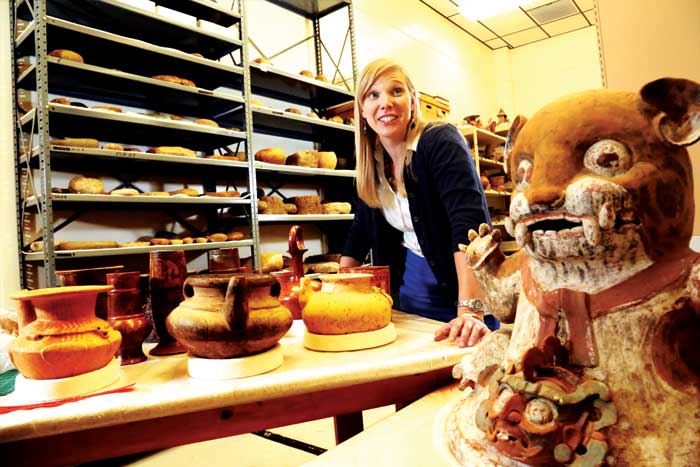
Museum curator Michele Koons shows indigenous vessels from Latin America in the Figgins Storage Area of the Denver Museum of Nature & Science. The large object at front is a Maya “incensario” or incense burner lid of a jaguar nicknamed “sweetie pie” by the donor.
It was a hot, dry day on the desert coast of Peru—one of the richest burial sites in the world, and an archaeologist’s playground. The team had been digging for hours. A layer of dust stuck to their perspiration. They knew there may be chamber tombs of priestesses underfoot, but didn’t know where, when suddenly …
“We came across two llama sacrifices, like huge llamas. Under that we got to adobe brick that started to line the tomb and kept digging to find the entrance to the tomb. Then we keep going and find eight sacrificial victims. We go down lower and find a coffin with copper cut out into these wonderful designs that was made as a mask. The masks were on top of the coffin and on the individual. We knew who the individual was because of images in Moche culture.”
Michele Koons is the curator of archaeology at the Denver Museum of Nature & Science (DMNS). She works at the museum but also continues to travel on excavations. “I love my job; it’s absolutely fantastic,” she says.
She is drawn to complex societies similar to life today but functioning thousands of years ago. How did they sustain themselves? What happened when things went wrong? She argues we’re not that different from ancient civilizations.
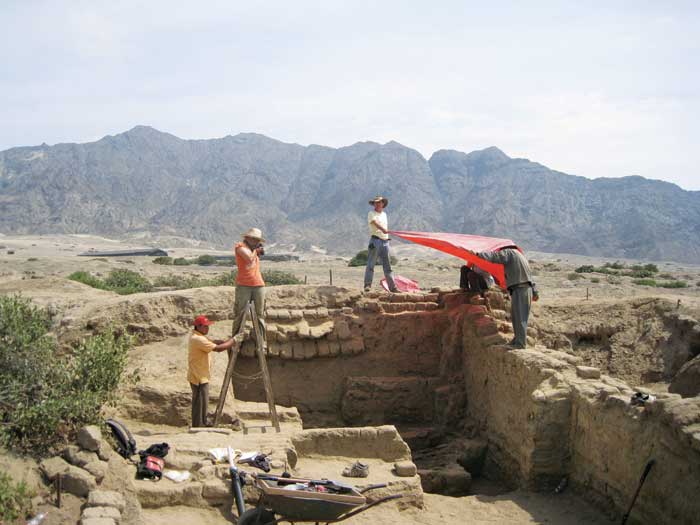
Again, this is at the site of Licapa II (ancient Peruvian site). I was photographing one of the excavation units from the ladder while my co-director and some workers held the red cloth to create shade on the feature below. Photo courtesy of Michele Koons.
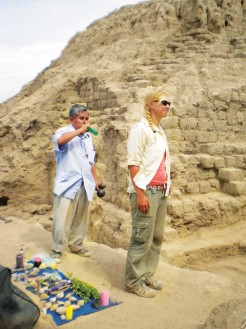
I had a local shaman come to cleanse the site (Licapa II) so as to appease the ancestors and let them know that we meant no harm. Here the shaman was performing the cleansing ritual on me by spitting rose water all over my back and head. That’s why I am making that face. Photo courtesy of Michele Koons.
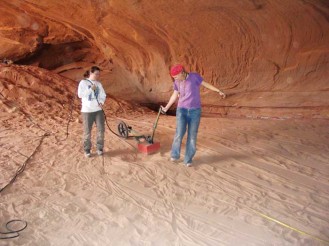
Ground-penetrating radar survey in High Cave, Utah circa 2005. This is just outside the Canyonlands. I am with Sara Gale, who is now Technical Trainer at Geophysical Survey Systems, Inc., the company that makes the radar system we were using in this photo. Photo courtesy of Michele Koons.
She specializes in South American archaeology, particularly the Moche (AD 300 to AD 1000), an elite Peruvian culture with intricate architecture, elaborate ceremonies and complex politics. Archaeologists discovered the first tomb of a priestess in 1991 and have continued finding more ever since, including the tomb by Koons and her team.
“There is that element of excitement when you go out in the field and make a discovery that no one has really put the pieces together for yet,” she says. When she speaks about her job her voice rises and falls in a musical way, singing with enthusiasm.
From an early age, Koons showed signs of a future archaeologist. As a child she spent every summer at her family’s beach house on the Jersey shore. She explored rocks and shells, searching for little creatures in the sand. She remembers digging to reach China.
And she listened in awe to her uncle’s much-exaggerated tales about finding Roman coins and chariots in his backyard.
But even into the beginning of college, a career in archaeology seemed far-fetched. She started as a physical therapy major at the University of Pittsburgh where she signed up for Alternative Spring Break, a service-learning trip for college students. Koons was chosen from 200 students to go to Bolivia, her first glimpse into exploring other cultures. Upon returning she changed her major to Latin American studies and anthropology.
While at the University of Pittsburgh, she did her first dig in Ithaca, New York, on an Iroquois reservation. “I just got it; I liked the techniques and discovering what they did in the past.” During study abroad in northern Chile, she completed photographic projects of some of the world’s oldest mummies. From that point, there was no turning back. She was hooked.
Koons did her master’s at the University of Denver on ground-penetrating radar, high-tech software that produces high-resolution images of scanned ground. She is particularly fond of the technology side of archaeology and recently bought a drone for 3D mapping in the field.
While working on her PhD at Harvard, she spent most of her time doing fieldwork in Peru. Sometimes she was just lucky enough to discover something new.
While part of her job does match the Indiana Jones image, she spends a lot of time at her desk reading and writing. Part of her work at DMNS involves studying ancient water and resource management strategies for modern day application. This summer she will explore the American southwest and how areas like Phoenix, with little water supply, survived in ancient times.
She also curates exhibits and studies collections not on display. She’s currently studying pots used to hold an ancient Peruvian fermented beverage called chicha. In collaboration with Denver Beer Co., she is helping create a beer inspired by chicha, which they will unveil July 21 at the brewery.
Despite her early impression of archaeology, Koons has made a career of it. She warns academic positions are hard to come by, though. This past year only three positions like hers were available in the U.S. with 300 to 400 applicants. “You really have to work hard to make a career out of archaeology, and I feel very lucky and fortunate.”
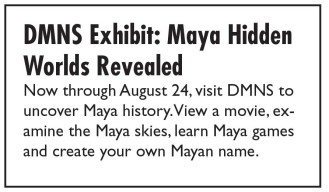




0 Comments